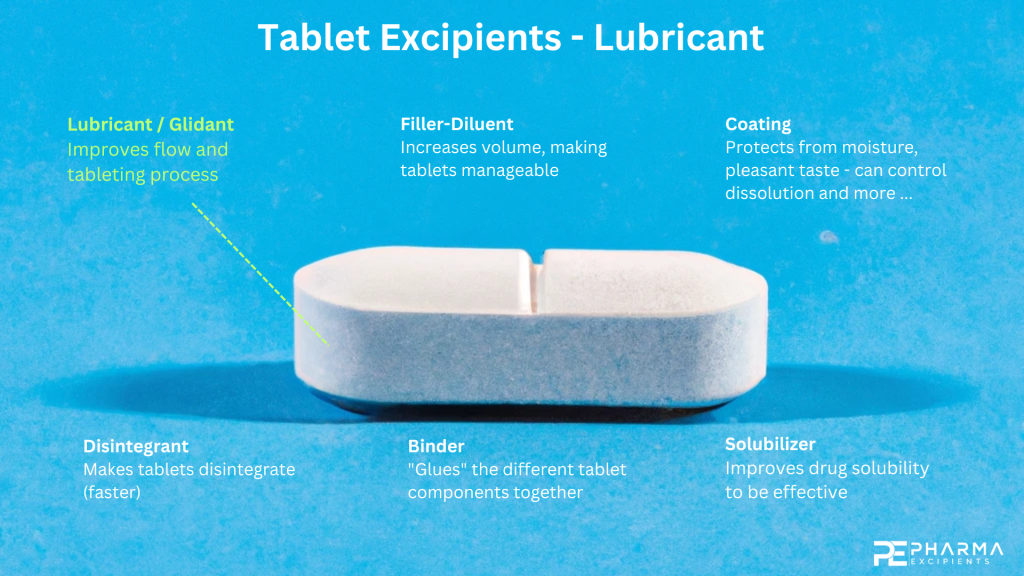Lubricants – Pharmaceutical Excipients
Lubricant excipients are substances that are added to tablet formulations to aid in the tableting process and to improve the flow of powders during the manufacturing of tablets. These excipients reduce friction and prevent the sticking of the tablet material to the surface of the die and punches, allowing for smoother tablet production and reducing the wear and tear on the tableting equipment.
Definition of lubricants by Peter C. Schmidt in “Pharmazeutische Hilfsstoffe” (1). Lubricants reduce the interparticle friction of a tableting mixture as well as the static and sliding friction between the tableting material and the die wall of the tablet press. In addition, they reduce the adhesion of the tablet to the surface of the lower punch at the moment of stripping. The effect of a lubricant on static and sliding friction can be quantified by measuring the ejection force. Adhesion to the punch surface is measured either directly by measuring the stripping force on the lower punch or directly by measuring the adhesive force on the upper punch.
Lubricant are distinct from glidants, which are substances added to powders to improve their flow properties, and anti-adherents, which are substances added to prevent the sticking of powders to surfaces.

Function of Lubricant Excipients
Lubricant excipients perform several important functions in the tableting process, including:
- Reducing friction between the particles of the powder mixture and between the particles and the surfaces of the tablet-forming equipment. This helps to prevent the material from becoming compacted or adhering to the surfaces of the die and punches, and ensures a smooth flow of the powder mixture during the compression process.
- Preventing adhesion of the tablet material to the surfaces of the die and punches. This helps to reduce the wear and tear on the tableting equipment and to prevent the formation of tablet defects, such as cracks or chips.
- Improving the flow properties of the powder mixture, which helps to ensure a uniform filling of the die and an even distribution of the active ingredient in the tablet.
- Improving the compressibility of the powder mixture, which can help to reduce the amount of force required to compress the tablet material into its final form.

Factors to consider when selecting Lubricant Excipients
When selecting a lubricant excipient, several factors should be considered, including:
- Compatibility with the active ingredient and other excipients in the formulation
- Potential impact on the stability and bioavailability of the final product
- Effect on the physical properties of the tablet, such as hardness, friability, and disintegration time
- Compatibility with the tableting equipment and manufacturing process
It is important to note that the use of lubricant excipients should be optimized in order to minimize any potential negative impact on the final product, and the selection of the appropriate excipient should be made with care and based on a thorough evaluation of its compatibility with the active ingredient and other excipients in the formulation.
In the pharmaceutical industry, the typical quantity of lubricant excipients used in tableting processes ranges from 0.5-5.0% of the total tablet weight, depending on the specific formulation and the type of lubricant used.
Definitions according to the European Pharmacopeia and USP/NF
According to the European Pharmacopeia, lubricants are defined as “substances added to the powder mixture to facilitate the flow of the mixture and to prevent the adhesion of the mixture to the surfaces of the die and punches during compression.” The United States Pharmacopeia/National Formulary (USP/NF) defines lubricants as “substances added to a powder mixture to reduce friction between the particles and between the particles and the surfaces of the tablet-forming equipment during compression.”
Lubricant Excipients
Common lubricant excipients used in the pharmaceutical industry include:
- Magnesium stearate
- Stearic acid
- Calcium stearate
- Sodium stearyl fumarate
- Polyethylene glycols
- Silicone dioxide (also known as colloidal silicon dioxide)
- Talc
- Beeswax
- Hydrogenated vegetable oil

In conclusion, lubricant excipients play a critical role in the pharmaceutical tableting process by reducing friction and preventing sticking during production. The selection of the appropriate lubricant excipient should be made with care, taking into consideration the compatibility with the active ingredient and other excipients in the formulation.
Lubricant Excipients on pharmaexcipients.com – in alphabetical order
| Product | Manufacturer |
| ALUBRA PG 100 | DuPont |
| Bonutab® | BIOGRUND GmbH |
| CompactCel® LUB | BIOGRUND GmbH |
| Compritol 888 ATO | Gattefosse |
| Compritol HD5 ATO | Gattefosse |
| DYNASAN® 118 | IOI Oleo |
| IMWITOR® 491 | IOI Oleo |
| IMWITOR® 900 (F) P | IOI Oleo |
| IMWITOR® 900 K | IOI Oleo |
| Kollitab™ DC 87 L | BASF |
| Kolliwax® HCO | BASF |
| Kolliwax® S | BASF |
| Kolliwax® S Fine | BASF |
| Kolliwax® SA | BASF |
| LubriSANAQ® | Pharmatrans SANAQ |
| Lubristar | Gangwal Healthcare Private Limited |
| LUBRITAB® | JRS Pharma |
| LUBRITAB® RBW | JRS Pharma |
| Magnesium Stearate | Roquette |
| Magnesium Stearate – HS | Roquette |
| Magnesium Stearate – LS | Roquette |
| Parteck® LUB CST (Calcium stearate vegetable grade) | Merck KGaA |
| Parteck® LUB MST (Magnesium Stearate Vegetable Grade) | Merck KGaA |
| Parteck® LUB STA 50 (Stearic acid 50 vegetable grade) | Merck KGaA |
| Precirol ATO 5 | Gattefosse |
| PROSOLV® EASYtab NUTRA CM | JRS Pharma |
| PROSOLV® EASYtab NUTRA GM | JRS Pharma |
| PROSOLV® EASYtab SP | JRS Pharma |
| PROSOLV® EASYtab SP LM | JRS Pharma |
| PRUV® | JRS Pharma |
| STARLAC | Meggle |
References
(1) „Pharmazeutische Hilfsstoffe“ Peter C. Schmidt · Siegfried Lang


